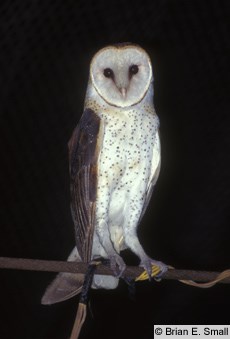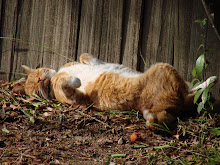
I just heard a barn owl call twice while I was out with Ruby for her nightly pre-bed stroll (to hear a typical barn owl call on youtube click here). It made me realize that while I used to hear barn owls and horned owls calling all the time in my neighborhood growing up and regularly heard barn owls calling in Davis, I haven't EVER heard them calling in all my night dog walks in our current neighborhood in Ventura. It might be the lack of mature street trees for nesting and perching in our neighborhood (we only have scattered crappy palms as our street trees and some smaller deciduous trees scattered about). Or maybe its the lack of abandoned lots, grassy meadows, or other areas with abundant small rodents for them to eat.
I don't know why they aren't here but two things struck me tonight. First, until now, I never noticed their ABSENCE. It is so much more difficult to notice the absence of something than its presence. It reminded me of a slightly related concept in ecology called the shifting baseline. With a shifting baseline a change in the ecosystem happens so gradually (sometimes over several human generations) that people don't even notice that a shift has occurred. The classic case of shifting baselines is in ocean fisheries where if you look at historic photos from fishing contests the prize winning fish are all huge but in modern photos they are wimpy little things. Yet despite this major change, people didn't really notice because it occurred gradually over decades. So the baseline value of the biggest fish may have gone down by an order of magnitude in terms of length or weight but we don't even notice.
My failure to notice the lack of calling barn owls felt like an unnoticed shift in my personal night time ecology.
My second pondering re:barn owls calling is regarding my recent interest in soundscapes - their value to people (especially soundscapes in our park), how they may have changed over time, and questions about how to monitor and manage soundscapes as a resource of the park. Hearing the owl calling at night made me realize (duh!) that one of the possible reasons why people are so interested in being out in the park at night may be because of all the cool sounds you hear at night. Plus the added value that you hear sounds more clearly at night (at least I think you do but I'm not sure why. If this is actually true I'm sure Tom or Mitch could explain it to me but I would likely either a) immediately forget the explanation or b) not really understand it in the first place. so take this bit with a grain of salt).
Anyway regardless, night sounds are AMAZING and natural sounds in general are one of the resources of the park that both people and animals value (animals need to be able to hear each other calling, hear predators approaching, etc.). I am struggling with how to monitor and manage our soundscapes as development occurs around us. I also think soundscapes are another area where shifting baselines could sneak up on us and our resources could be degrading without us even noticing.
One last random thought before bed - thinking about animals needing to hear predators approach takes me back to when I had a job walking through the sagebrush in the dead of night with a tape player playing snow mobile engine noises so I could sneak up on sage grouse and they wouldn't hear me bashing through the underbrush. Urban noise can really throw off the creatures, that is for sure.
P.S. Did you know that barn owls are in their own family (Tytonidae) and that they are the only species in that family? Also their cool facial disk (the crazy feathers around their eyes and bill) is designed to focus sound to their ears so they can hear the quiet squeaking of mice and their tiny footsteps (or so the ornithologists think anyway). All the better to hear you with my dear (and then to eat you!).
P.P.S. Mitch asked me once whether there are any cases where the female is showy than the male in birds. Typically females are inconspicuous and if anyone is going to be colorful it is the male. Ecologists think the bright colors of males both make them visible to mates and are a measure of their fitness. For females, who typically have to sit on the nest, blending in is key. At the time Mitch asked me I said I didn't know of any cases where the female was showier and there might not be any for the reasons above (in many raptors the female is bigger than the male, but not typically more colorful). It turns out that barn owls are one of the rare cases where the females are "showier" than the males although it seems like a bit of a stretch to me (the females have more rusty coloring and more distinctive spots). Check out pictures on the cornell lab web page and judge for yourself.

No comments:
Post a Comment